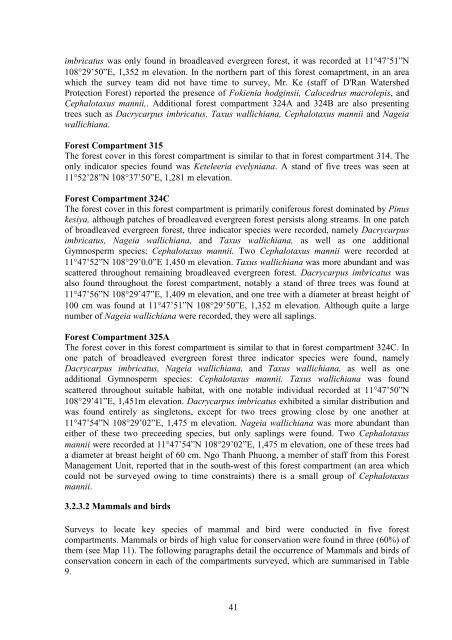a.TFF_rpt_on identification-planning - HCV Resource Network
a.TFF_rpt_on identification-planning - HCV Resource Network
a.TFF_rpt_on identification-planning - HCV Resource Network
Create successful ePaper yourself
Turn your PDF publications into a flip-book with our unique Google optimized e-Paper software.
imbricatus was <strong>on</strong>ly found in broadleaved evergreen forest, it was recorded at 11°47’51”N<br />
108°29’50”E, 1,352 m elevati<strong>on</strong>. In the northern part of this forest comaprtment, in an area<br />
which the survey team did not have time to survey, Mr. Ke (staff of D'Ran Watershed<br />
Protecti<strong>on</strong> Forest) reported the presence of Fokienia hodginsii, Calocedrus macrolepis, and<br />
Cephalotaxus mannii,. Additi<strong>on</strong>al forest compartment 324A and 324B are also presenting<br />
trees such as Dacrycarpus imbricatus, Taxus wallichiana, Cephalotaxus mannii and Nageia<br />
wallichiana.<br />
Forest Compartment 315<br />
The forest cover in this forest compartment is similar to that in forest compartment 314. The<br />
<strong>on</strong>ly indicator species found was Keteleeria evelyniana. A stand of five trees was seen at<br />
11°52’28”N 108°37’50”E, 1,281 m elevati<strong>on</strong>.<br />
Forest Compartment 324C<br />
The forest cover in this forest compartment is primarily c<strong>on</strong>iferous forest dominated by Pinus<br />
kesiya, although patches of broadleaved evergreen forest persists al<strong>on</strong>g streams. In <strong>on</strong>e patch<br />
of broadleaved evergreen forest, three indicator species were recorded, namely Dacrycarpus<br />
imbricatus, Nageia wallichiana, and Taxus wallichiana, as well as <strong>on</strong>e additi<strong>on</strong>al<br />
Gymnosperm species: Cephalotaxus mannii. Two Cephalotaxus mannii were recorded at<br />
11°47’52”N 108°29’0.0”E 1,450 m elevati<strong>on</strong>. Taxus wallichiana was more abundant and was<br />
scattered throughout remaining broadleaved evergreen forest. Dacrycarpus imbricatus was<br />
also found throughout the forest compartment, notably a stand of three trees was found at<br />
11°47’56”N 108°29’47”E, 1,409 m elevati<strong>on</strong>, and <strong>on</strong>e tree with a diameter at breast height of<br />
100 cm was found at 11°47’51”N 108°29’50”E, 1,352 m elevati<strong>on</strong>. Although quite a large<br />
number of Nageia wallichiana were recorded, they were all saplings.<br />
Forest Compartment 325A<br />
The forest cover in this forest compartment is similar to that in forest compartment 324C. In<br />
<strong>on</strong>e patch of broadleaved evergreen forest three indicator species were found, namely<br />
Dacrycarpus imbricatus, Nageia wallichiana, and Taxus wallichiana, as well as <strong>on</strong>e<br />
additi<strong>on</strong>al Gymnosperm species: Cephalotaxus mannii. Taxus wallichiana was found<br />
scattered throughout suitable habitat, with <strong>on</strong>e notable individual recorded at 11°47’50”N<br />
108°29’41”E, 1,451m elevati<strong>on</strong>. Dacrycarpus imbricatus exhibited a similar distributi<strong>on</strong> and<br />
was found entirely as singlet<strong>on</strong>s, except for two trees growing close by <strong>on</strong>e another at<br />
11°47’54”N 108°29’02”E, 1,475 m elevati<strong>on</strong>. Nageia wallichiana was more abundant than<br />
either of these two preceeding species, but <strong>on</strong>ly saplings were found. Two Cephalotaxus<br />
mannii were recorded at 11°47’54”N 108°29’02”E, 1,475 m elevati<strong>on</strong>, <strong>on</strong>e of these trees had<br />
a diameter at breast height of 60 cm. Ngo Thanh Phu<strong>on</strong>g, a member of staff from this Forest<br />
Management Unit, reported that in the south-west of this forest compartment (an area which<br />
could not be surveyed owing to time c<strong>on</strong>straints) there is a small group of Cephalotaxus<br />
mannii.<br />
3.2.3.2 Mammals and birds<br />
Surveys to locate key species of mammal and bird were c<strong>on</strong>ducted in five forest<br />
compartments. Mammals or birds of high value for c<strong>on</strong>servati<strong>on</strong> were found in three (60%) of<br />
them (see Map 11). The following paragraphs detail the occurrence of Mammals and birds of<br />
c<strong>on</strong>servati<strong>on</strong> c<strong>on</strong>cern in each of the compartments surveyed, which are summarised in Table<br />
9.<br />
41
















